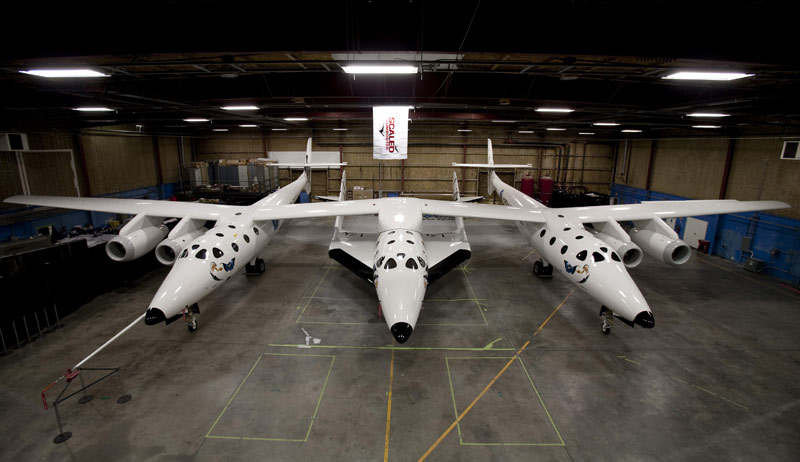Public Space Travel: Reality or Mirage?

MOJAVE, California – Today's planned unveiling of SpaceShipTwo here at the Mojave Air and Space Port is generating high-altitude hope and a good dose of hype for public space travel, yet there are those who wave an advisory flag.
One such person is Roger Launius, Senior Curator in the Division of Space History at the Smithsonian Institution's National Air and Space Museum in Washington, D.C.
SpaceShipTwo is a carbon composite kissing cousin to SpaceShipOne – the non-governmental, single piloted craft that bagged the $10 million Ansari X Prize purse by flying repeat treks to suborbital space in 2004.
Launius measures up those early flights of SpaceShipOne and the promissory note it delivered in terms of flying future rubbernecking space tourists.
"It seems to me that five years after the flight of SpaceShipOne, space tourism, while still stirring because of its promise of allowing anyone to participate, remains a hazy mirage on the distant horizon. I wish it were otherwise," Launius told SPACE.com via email.
At a basic level, Launius pointed out, tourism at any time and place in human history has required a trio of major components:
- A discretionary income available for leisure travel;
- Ample leisure time to spend on both preparations for and taking the trips themselves; and
- An infrastructure supporting tourism that offers accommodations, food and amenities, transportation systems, and attractions to see and do at the place visited.
"None of these three components are available in abundance for space tourism, although all exist to a small degree," Launius said. "They will have to be created or expanded significantly to achieve the goal of opening space to the public. This will be a challenging task involving significant investment, especially in infrastructure, and either a significant reduction in the costs of space tourism to broaden the market or a greater attraction for those with enormous fortunes to spend on their leisure activities."
Get the Space.com Newsletter
Breaking space news, the latest updates on rocket launches, skywatching events and more!
Launius suggested that, in the next few years, there seems "good reason" to believe that sub-orbital space tourism will become a reality.
"It may well remain the province of wealthy thrill-seekers, essentially the same class of those who climb Mount Everest, rather than the masses who dominate the current $600 billion-plus per year tourism industry."
Furthermore, a tiny elite of multi-millionaires, Launius explained, may continue to fly aboard Soyuz capsules to Earth orbit, but the reality is that orbital space tourism is many decades away absent a major breakthrough in space access. "Until that happens we may be able to count the number of orbital space tourists on our fingers for years to come," he said.
Drawing upon his aerospace history background, Launius said that a useful analogy illustrating this problem might be the transition from propeller-driven aircraft to jets during World War II.
"By the 1930's, propulsion engineers had squeezed most of the performance that they could out of reciprocating engines. To reach a new plateau of performance they needed a new propulsion technology. Jet engines revolutionized the nature of flight, and made economical for the first time mass movement of people by air," Launius said.
Perhaps there is some propulsion breakthrough that will revolutionize space access and make tourism a reality, Launius continued. "At present, engineers are industriously modifying existing technologies to squeeze out of them a few more percentage points of capability."
While Launius is hopeful of being wrong, and that this analogy does not hold true for space tourism, "but if it does, this is a prescription for the adventurers to reach space -- most of them sub-orbital -- but not for space tourism as most envision it," he concluded.
- More About the Planned SpaceShipTwo Unveiling
- Future of Flight: Space Tourism, Investment and Technology
- VIDEO: Virgin Galactic: Let the Journey Begin
Leonard David has been reporting on the space industry for more than five decades. He is past editor-in-chief of the National Space Society's Ad Astra and Space World magazines and has written for SPACE.com since 1999.
Join our Space Forums to keep talking space on the latest missions, night sky and more! And if you have a news tip, correction or comment, let us know at: community@space.com.

Leonard David is an award-winning space journalist who has been reporting on space activities for more than 50 years. Currently writing as Space.com's Space Insider Columnist among his other projects, Leonard has authored numerous books on space exploration, Mars missions and more, with his latest being "Moon Rush: The New Space Race" published in 2019 by National Geographic. He also wrote "Mars: Our Future on the Red Planet" released in 2016 by National Geographic. Leonard has served as a correspondent for SpaceNews, Scientific American and Aerospace America for the AIAA. He has received many awards, including the first Ordway Award for Sustained Excellence in Spaceflight History in 2015 at the AAS Wernher von Braun Memorial Symposium. You can find out Leonard's latest project at his website and on Twitter.